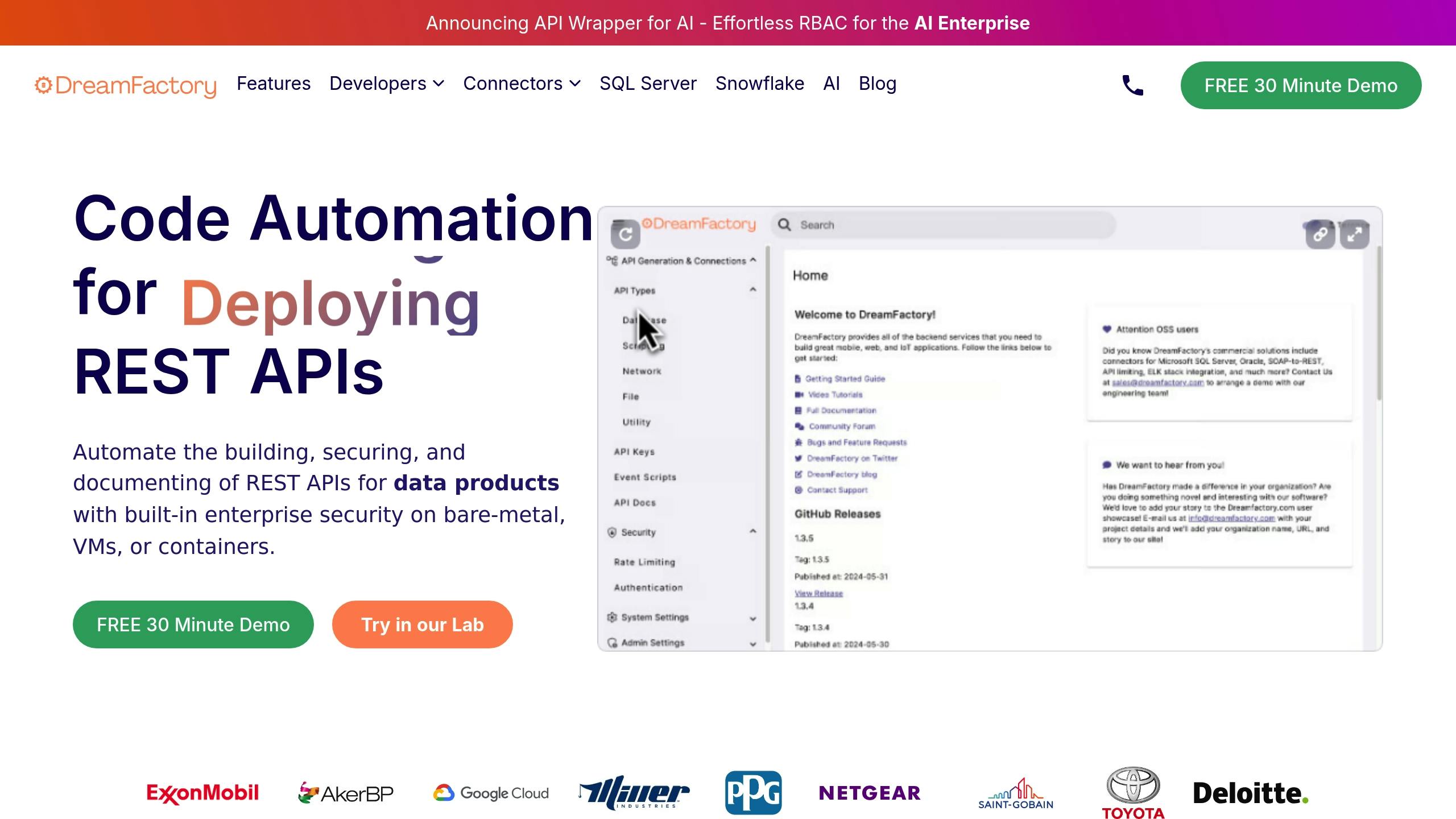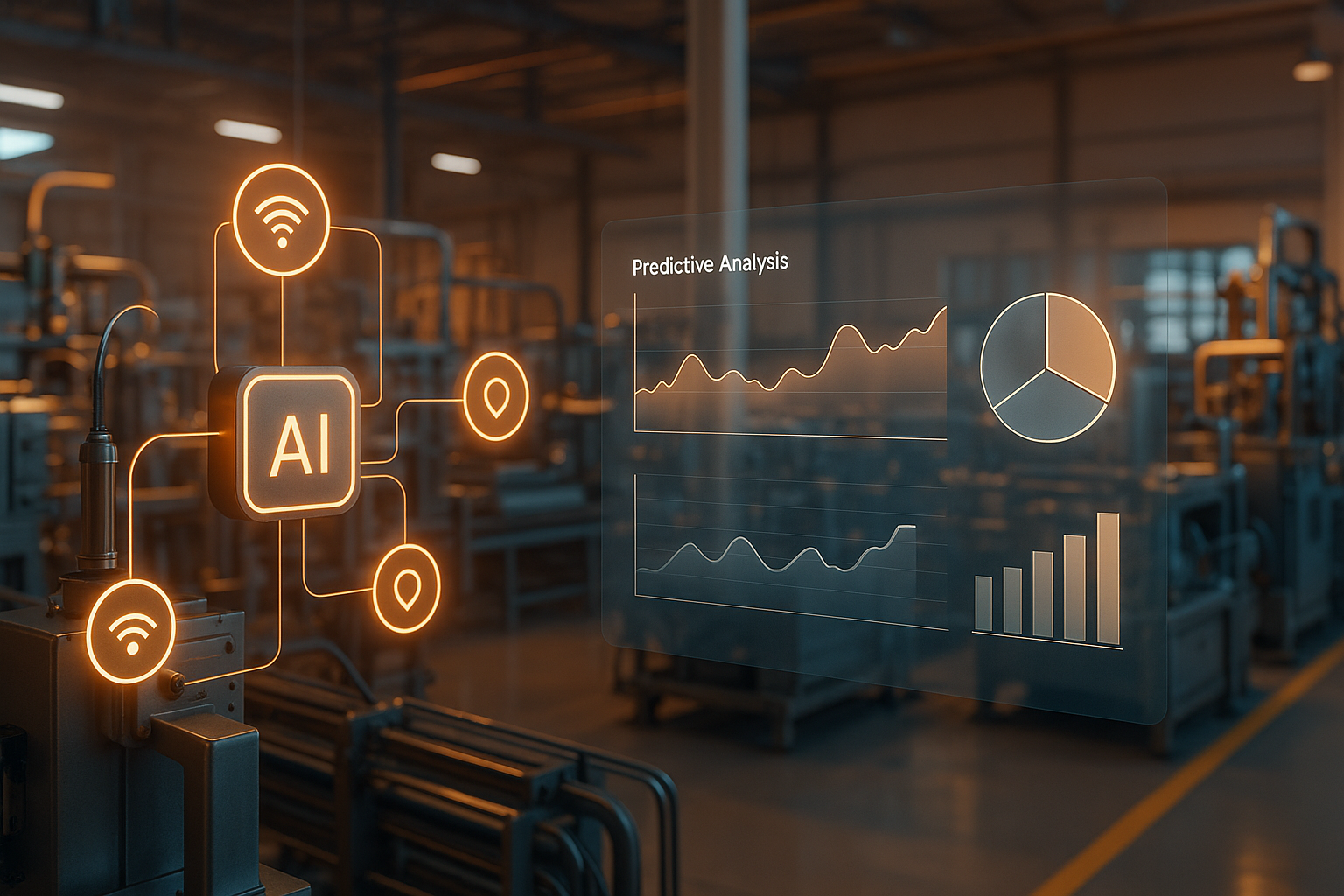Manufacturers are drowning in data but struggling to use it effectively. Sensors on factory floors generate massive amounts of information - temperature, vibration, pressure - but much of it sits in isolated systems, creating "data silos." These silos prevent real-time decisions, predictive maintenance, and cost savings.
The solution? Data AI Gateways. These gateways unify isolated sensors, process data locally with edge computing, and translate protocols to connect legacy equipment with modern systems. By integrating data, manufacturers can predict equipment failures, reduce downtime, and cut costs.
Key benefits include:
Predictive maintenance: Cuts maintenance costs by 5–10% and boosts uptime by 10–20%.
Real-time monitoring: Reduces delays and prevents safety risks.
Cost savings: Companies save 20–25% on operations with integrated data systems.
With AI-driven API management, these gateways simplify integration, automate security, and enable fast, scalable connections. As IoT grows to over 30 billion devices by 2030, adopting AI-powered gateways is critical for staying competitive.
This article explores how Data AI Gateways transform industrial IoT by connecting devices, improving analytics, and ensuring security in an increasingly digital manufacturing landscape.
How AI is Reshaping IoT | Velocity IoT's Anthony Protopsaltis

How Data AI Gateways Change Industrial IoT
Data AI Gateways are reshaping industrial IoT by transforming raw sensor data into actionable insights and connecting isolated devices to centralized systems.
The industrial IoT gateway market experienced a 14.7% growth from 2021 to 2022, reaching $860 million. This growth reflects the increasing demand to unify diverse systems, as IoT devices are projected to surpass 30 billion by 2030. Understanding how gateways function is crucial to grasping their role in this transformation.
Central Data Integration
Data AI Gateways act as hubs that consolidate data from sensors, I/O devices, and PLCs, standardizing it for compatibility with cloud systems. By creating a common data model, they enable seamless communication across machines, devices, and systems.
Instead of relying on point-to-point connections between individual sensors and backend systems, manufacturers can route all data through a single gateway. This simplifies data management by handling formatting and transmission complexities in one place.
AI-powered gateways elevate this process further by optimizing device operations based on production needs and equipment status. They can adjust data collection rates, prioritize critical information, and even make decisions locally, bypassing the need for cloud-based processing.
This integration bridges the gap between operational technology (OT) and information technology (IT) teams, breaking down silos that often hinder industrial digitization. Alongside centralized integration, edge computing ensures real-time data processing, which is essential for critical industrial tasks.
Edge Computing for Real-Time Data
Edge computing within these gateways processes data locally, reducing latency to as low as 1–10 milliseconds - an essential feature in industrial environments.
In these settings, even a few milliseconds of delay can mean the difference between a smooth operation and a safety hazard. Edge computing addresses this by handling critical tasks on-site, without relying on distant cloud servers.
Take the example of Vitesco Technologies in Italy, where they deployed Zerynth's 4ZeroBox, an on-premises IoT solution. This system enabled them to predict pneumatic valve failures 24 hours in advance, minimizing downtime and boosting productivity. With local processing, they could act on predictive insights immediately, rather than waiting for cloud-based analysis.
Edge gateways also help manage bandwidth by filtering and processing data locally, sending only essential information to the cloud. Considering the 402.74 million terabytes of data generated globally each day, this approach reduces network congestion and cuts data transmission costs.
"In IIOT (Industrial Internet of Things) Edge Computing serves a vital role, as this fast processing and informative and automatic decision making assist with the continuous flow of the production line, while cloud and enterprise applications are mainly used for dictating procedures and long-periods of time monitoring & learning."
- Gabi Daniely, Chief Strategy & Marketing Officer, CoreTigo
Protocol Translation and System Compatibility
Another critical role of Data AI Gateways is ensuring compatibility between legacy systems and modern IoT devices. Many industrial facilities operate a mix of old and new equipment, each using different data protocols. Gateways act as translators, converting data from older systems into formats compatible with modern platforms.
Legacy equipment often relies on outdated protocols that don't naturally integrate with cloud-based systems. Gateways resolve this issue, allowing manufacturers to modernize their infrastructure without replacing costly equipment.
These gateways connect and standardize data across all machinery, whether it’s a modern machine control system or a decades-old sensor. This universal compatibility allows older equipment to contribute data to predictive analytics alongside newer devices, creating a unified system.
AI-Powered API Generation for Easy Integration
AI-powered API generation is reshaping how industrial systems connect with modern applications, building on the foundation of centralized data integration and edge processing. Traditionally, creating APIs to bridge industrial systems with contemporary applications required significant manual coding, testing, and upkeep. For complex industrial setups, this process could stretch over weeks or even months.
With AI in the mix, this landscape is evolving. AI automates the creation of secure, scalable APIs directly from industrial data sources, addressing a growing challenge. Enterprises today manage an average of over 1,000 APIs, yet 85% lack rate limiting, and 76% face medium-to-high security risks.
Automated API Creation
AI tools streamline the development process by automatically generating REST APIs from various industrial data sources, including databases, sensors, and legacy systems. This transformation can occur in just minutes, turning these sources into connected endpoints.
By leveraging AI-generated code snippets, automated testing, and natural language processing (NLP)-driven documentation, developers save 15–20 hours each month and can onboard new systems 35% faster. These tools analyze data structures and access patterns, ensuring that API endpoints align with industry standards.
The scale of industrial operations makes this automation even more crucial. With investments in IoT ecosystems projected to exceed $1 trillion by 2026, manual API development simply can't keep up with the surging demand for integration.
AI-powered platforms also enhance the developer experience by providing real-time support, such as intelligent code suggestions and recommendations. This not only speeds up development but also reduces the time it takes to bring IoT applications to market.
These advancements enable secure and adaptable API management that evolves alongside industrial requirements.
Secure and Scalable API Management
In the industrial IoT space, security remains a pressing concern, with 20% of organizations already experiencing cyberattacks. AI-driven API management tackles these challenges by automating security measures and continuously monitoring for threats.
Role-Based Access Control (RBAC) ensures that only authorized users can access specific data streams. For instance, maintenance technicians might view equipment status, while executives access high-level metrics. AI further refines this by analyzing user behavior and dynamically adjusting permissions to mitigate risks.
API key management also benefits from AI oversight. The system can rotate keys automatically, flag suspicious activity, and revoke access if anomalies arise - a critical safeguard given that nearly one-third of customer-facing APIs still lack HTTPS protection.
OAuth 2.0 integration strengthens authentication for both human users and machine-to-machine communication. AI optimizes this process by predicting authentication needs and pre-authorizing trusted connections, reducing delays in time-sensitive industrial applications.
|
Traditional API Management |
AI-Driven API Management |
|---|---|
|
Rule-based policies |
Adaptive learning models |
|
Manual documentation |
NLP-generated specifications |
|
Reactive security |
Proactive threat prevention |
Organizations leveraging AI for API management report 40% faster incident resolution and a 30% boost in developer productivity. These improvements stem from AI's ability to anticipate and resolve issues before they disrupt operations.
This shift toward AI-driven API management lays the groundwork for DreamFactory's advanced capabilities.
DreamFactory's API Management Features

DreamFactory simplifies industrial IoT integration with its robust API management platform. It can instantly generate REST APIs from any database or data source, eliminating the lengthy manual development process.
The platform supports over 20 connectors, including Snowflake, SQL Server, and MongoDB. Manufacturers can seamlessly link legacy databases, modern cloud systems, and IoT platforms through a unified interface. DreamFactory also automates database schema mapping, creating endpoints without additional effort.
Security is a top priority, with built-in features like RBAC, API key management, and OAuth integration. These tools ensure industrial data stays secure while remaining accessible to authorized users and systems. For industries subject to stringent regulations, DreamFactory maintains GDPR and HIPAA compliance.
Customization is another strength. Developers can use Python, PHP, NodeJS, or V8JS for server-side scripting, enabling tailored business logic, data transformations, and workflows without overhauling existing infrastructure.
The platform also addresses a common pain point: documentation. Auto-generated Swagger documentation ensures APIs are well-documented and easy to integrate, reducing delays and errors in industrial environments.
DreamFactory offers deployment flexibility, supporting Kubernetes, Docker, and Linux environments. This allows manufacturers to deploy APIs wherever needed, whether for enhanced security in on-premises setups or to minimize latency.
With unlimited API creation and volume capabilities, the platform scales effortlessly to support the vast number of devices and systems involved in industrial IoT deployments. Additionally, ELK stack integration provides detailed logging and reporting, giving manufacturers insights into API performance, usage trends, and security concerns. This data-driven approach enables ongoing optimization and helps anticipate future integration needs.
From Predictions to Action: Benefits of Better Analytics
Data AI Gateways take disconnected sensor data and turn it into actionable insights, helping industries improve operations in measurable ways. These advanced analytics pave the way for smarter maintenance strategies, real-time adjustments, and significant cost reductions.
Predictive Maintenance and Problem Detection
One of the standout uses of Data AI Gateways is predictive maintenance. Unlike traditional maintenance routines or reactive fixes, predictive methods rely on real-time data and machine learning to anticipate equipment failures before they happen.
Connected sensors monitor key metrics like temperature, vibration, and pressure. AI algorithms analyze this data alongside historical trends to spot anomalies and predict potential issues.
"When it's built on high-quality data and domain and industry expertise, predictive analytics doesn't just provide early warning alerts. It provides clear guidance on the forecasted time to failure and the most efficient mitigating action, and it determines the optimal time to perform the maintenance action (or the necessary production adjustments to make it to the next planned outage)."
- Petra Nieuwenhuizen, AVEVA's Senior Product Marketing Manager for Asset Performance Management and AI
Real-world results highlight the impact of these systems. For instance, PETRONAS saved $33 million and improved asset utilization by 0.1% per plant through an AI-powered analytics program. This system issued 51 warnings, including 12 high-risk alerts, slashing unplanned downtime and delivering a 20x return on investment. Similarly, Duke Energy saved over $34 million in a single event by using a no-code AI solution. Another example includes a leading automotive manufacturer that reduced unplanned downtime by 30% with AI-driven predictive maintenance.
Beyond cost savings, predictive maintenance also enhances safety and minimizes disruptions. By scheduling maintenance during off-peak hours, companies can avoid production delays and address hazards before they escalate. These systems can reduce planning time by 20–50%, boost equipment uptime by 10–20%, and lower maintenance costs by 5–10%.
Real-Time Monitoring for Better Operations
Real-time monitoring powered by Data AI Gateways is transforming decision-making in industrial operations. Continuous data streams from connected devices allow for immediate responses to changing conditions, eliminating the delays of periodic reports or manual checks.
AI algorithms analyze these data streams to detect anomalies or patterns that demand attention. By processing data locally at the edge, these gateways enable near-instant decisions, preventing costly disruptions or safety incidents.
One example is Siram Veolia, which used AI-driven automation to streamline service requests, cutting down delays and reducing unnecessary communication. In coal preparation plants, vibration meters on pump motors detect acceleration spikes, signaling potential failures. This early warning system helps maintenance teams act before breakdowns occur, avoiding days of halted production.
Airbus has also adopted real-time monitoring through its "Factory of the Future" initiative. By integrating sensors into tools, shop floor machines, and wearable devices like smart glasses, Airbus reduced errors and improved safety across its jetliner production facilities.
According to McKinsey, predictive maintenance supported by real-time monitoring can cut unplanned downtime by up to 50% while increasing labor productivity by almost 30%. With an estimated 55.7 billion IoT devices expected to generate 80 zettabytes of data by 2025, the ability to process this information in real time will only grow in importance.
Cost and Efficiency Gains
Improved analytics not only enhance maintenance but also drive gains in energy efficiency, resource use, and overall operations. The financial benefits of Data AI Gateways extend well beyond maintenance savings, offering broad operational improvements that directly impact profitability.
Companies adopting IoT and AI technologies have reported impressive results, including an 82% boost in efficiency, 49% fewer product defects, and a 45% increase in customer satisfaction. These outcomes are tied to better visibility into processes, faster resolution of quality issues, and more responsive customer service.
Energy optimization is another key area. By monitoring equipment performance in real time, manufacturers can identify inefficiencies and adjust operations to cut energy use - an increasingly important advantage as energy costs rise and sustainability goals grow stricter.
These insights also improve resource utilization. Companies can pinpoint underused assets, streamline production schedules, and reduce waste through smarter demand forecasting and inventory management.
AI-driven monitoring frees up technicians to focus on more complex tasks, boosting labor productivity. It also enhances supply chain management by improving coordination with suppliers and enabling more accurate delivery timelines. These improvements strengthen customer relationships and can even justify premium pricing.
Over time, these benefits add up, giving companies a competitive edge. Businesses that fully embrace Data AI Gateway solutions often find that their operational efficiency becomes a market differentiator, driving growth and increasing profit margins.
Security, Compliance, and Deployment in Industrial IoT
Deploying Data AI Gateways in industrial settings requires a strong focus on security, adherence to regulations, and adaptable deployment strategies. With IoT investments projected to surpass $1 trillion by 2026, safeguarding sensitive operational data while ensuring operational efficiency is more critical than ever.
Protecting Data Security
Industrial IoT systems handle highly sensitive data, making robust security measures a must. Data AI Gateways secure data from sensors to analytics platforms by employing multiple layers of protection.
Key security features include TLS encryption for secure data transmission and X.509 certificates or Kubernetes tokens for reliable authentication. Secure boot mechanisms ensure that only verified software runs on gateway devices, blocking unauthorized firmware.
Role-based access controls (RBAC) limit system access based on individual roles and responsibilities, adhering to the principle of least privilege. For MQTT broker communications, gateways grant topic-specific access, ensuring users only have the permissions they need.
Critical systems benefit from multi-factor authentication (MFA), which adds an extra layer of protection for IoT devices and administrative accounts. Advanced practices like OAuth 2.0 with OpenID Connect enable robust authentication and authorization, while JSON Web Tokens (JWTs) help secure data exchanges between devices and servers.
"As AI systems become deeply embedded in core operations, securing the data that fuels them is not optional; it is essential."
- Industrial Cyber
Emerging encryption technologies, such as quantum-resistant and homomorphic algorithms, are also gaining traction, offering advanced methods for processing encrypted data. These practices align with U.S. security standards and regulations.
Meeting U.S. Regulations
Regulatory compliance is a cornerstone of industrial IoT deployment. According to Transforma Insights, compliance concerns now outweigh cost and connectivity challenges in IoT.
The U.S. Cyber Trust Mark, managed by the FCC, sets security standards for connected devices, including Industrial IoT systems. To earn this certification, manufacturers must meet strict requirements, such as strong authentication, regular updates, and vulnerability protection. This program ensures adherence to IoT security best practices, from development to lifecycle management.
The NIST Cybersecurity Framework remains the benchmark for integrating security throughout a product's lifecycle. NIST Internal Report 8563 provides updated guidance on operational technology, secure end-of-life strategies, and privacy risk modeling. Additionally, the IoT Cybersecurity Improvement Act of 2020 mandates minimum security standards for IoT devices used by federal agencies.
Industries like healthcare must also comply with HIPAA/HITECH regulations, which govern the privacy and security of electronic health records and patient data.
"Compliance isn't just about avoiding fines; it's about securing your operations and building trust with your stakeholders."
- Kevin Hilscher, Author, DigiCert
By meeting these regulatory demands, organizations not only avoid legal issues but also strengthen operational reliability and stakeholder trust. Platforms like DreamFactory incorporate features for GDPR, HIPAA, and Cyber Trust Mark compliance, simplifying the process.
Flexible Deployment Options
Security and compliance are vital, but deployment flexibility is equally important for seamless integration into industrial systems. Data AI Gateways offer a range of deployment options, including managed services, local setups, and Kubernetes-based enterprise solutions.
Managed deployment: Ideal for organizations looking for a quick setup without worrying about infrastructure. Service providers handle updates, infrastructure management, and maintenance, allowing businesses to focus solely on data integration and analytics.
Local deployment: Offers maximum control and customization. Organizations can use Node.js servers, Docker containers, or Docker Compose for multi-service setups tailored to their needs.
Kubernetes-based enterprise deployment: Designed for large-scale environments, Kubernetes provides features like load balancing, resource management, automatic rollbacks, and secure handling of sensitive data. It also supports self-healing capabilities to enhance reliability.
Docker containerization further simplifies deployment by offering isolation, portability, and scalability. Enterprise deployments often include advanced features like secure key management, access control, caching, and PII redaction. DreamFactory supports a wide range of environments, from edge computing setups to large-scale industrial operations, ensuring flexibility for diverse use cases.
When choosing a deployment approach, organizations should assess their specific needs, including the level of control required, infrastructure capabilities, security priorities, and compliance obligations. Whether opting for managed, local, or enterprise solutions, the decision will depend on factors like technical expertise, budget, and regulatory considerations.
Conclusion: Getting the Most from Industrial IoT
The shift from isolated sensors to interconnected, predictive systems highlights the transformation Industrial IoT has undergone. Today, businesses harness integrated sensor data to gain actionable insights, allowing them to maximize the value of their investments.
The numbers tell a compelling story: the global Industrial IoT market is projected to hit $110.6 billion by 2028. Companies leveraging AI and IIoT technologies are already seeing measurable benefits, such as cutting maintenance costs by 40% and reducing downtime by 50%.
Success stories back these trends. For example, BMW's Regensburg plant uses predictive maintenance to avoid conveyor system breakdowns. Similarly, a global chemical plant slashed urgent maintenance tasks from 43% of total activities by implementing predictive systems across 33 pieces of equipment.
The real value of Industrial IoT lies in integrating AI at its core. To fully capitalize on this potential, businesses need to rethink their operations, treating AI and IIoT as essential components rather than optional add-ons. Platforms that streamline and secure IoT integration are key to this transformation.
DreamFactory is one such platform, offering the tools necessary for scalable and secure Industrial IoT solutions. Its stateless, portable design enables deployment across bare metal, virtual machines, or containers, providing the adaptability modern industries require.
A successful Industrial IoT strategy begins with evaluating existing systems. From there, businesses can adopt a microservices architecture, using APIs to enable real-time data sharing across platforms. The goal is to create an integrated ecosystem where data flows freely - from sensors to analytics platforms - empowering real-time decision-making and predictive capabilities. With this approach, manufacturers can stay ahead in the ongoing digital transformation.
The companies that thrive will be those that turn disconnected sensor data into intelligent, predictive systems. By adopting the right Data AI Gateway platform and a forward-thinking strategy, organizations can achieve operational efficiency, cost savings, and the competitive edge needed to lead in the digital era.
FAQs
Data AI Gateways address the challenge of isolated sensor data in industrial IoT by serving as centralized hubs that bring together and integrate information from various sensors. They simplify how data moves across systems, eliminating barriers between disconnected sources.
By converting scattered data into a unified, easy-to-access format, these gateways enable real-time monitoring, predictive maintenance, and more informed decision-making. This improves operational workflows and boosts the precision of predictive analytics, allowing businesses to get the most out of their IoT data.
Edge computing takes Data AI Gateways to the next level by processing data right at its origin - think IoT sensors - rather than depending entirely on cloud systems. This approach slashes latency, cuts down on bandwidth usage, and enables real-time decision-making, which is crucial for industries that rely on split-second operations.
By managing AI tasks locally, edge computing ensures systems can keep running smoothly even if the network goes down. This reliability is a game-changer for applications like real-time monitoring, predictive maintenance, and automated decision-making. The result? Faster responses, greater efficiency, and higher productivity across industrial settings.
Data AI Gateways serve as a bridge, connecting older systems with modern IoT devices by translating different protocols and data formats. Through the use of API gateways and middleware, they enable smooth communication, allowing legacy systems to operate alongside cutting-edge IoT technologies without requiring expensive upgrades or replacements.
These gateways also enhance legacy systems by embedding AI capabilities. By processing data directly at the gateway level, they deliver real-time insights and predictions. For systems that lack APIs, gateways can pull data using methods like direct database access or file parsing, transforming it into formats suitable for advanced AI analytics. This method simplifies integration while maintaining the existing infrastructure.
Kevin McGahey is an accomplished solutions engineer and product lead with expertise in API generation, microservices, and legacy system modernization, as demonstrated by his successful track record of facilitating the modernization of legacy databases for numerous public sector organizations.
























 Blog
Blog


